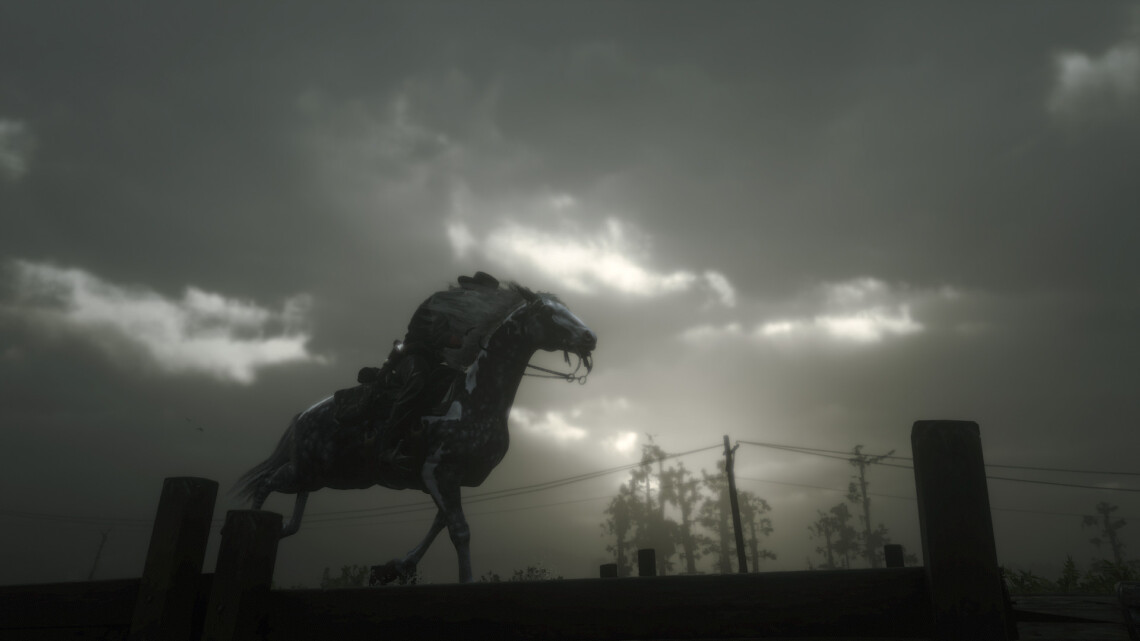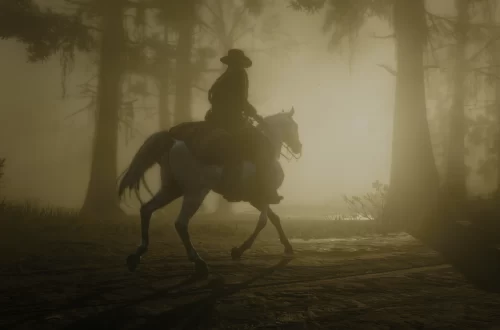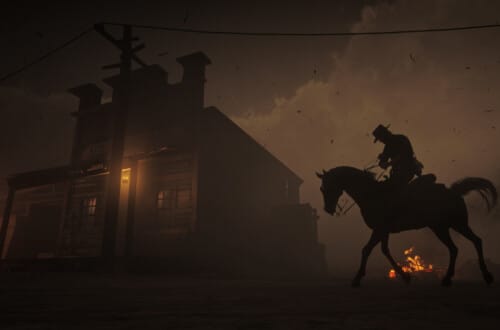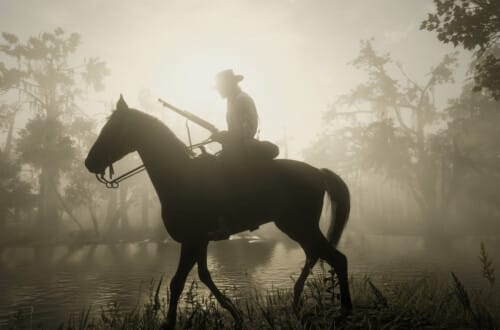How Arthurian characters inspired those found in Red Dead Redemption 2, such as Molly O’Shea and Kieran Duffy.
All articles on this site feature detailed discussion of literary allusions in Red Dead Redemption 2, and as such contain unmarked major and minor spoilers for the game, and occasionally the eventual fates of some characters in Red Dead Redemption. Read at your own risk.
Many characters from the legends surrounding the Knights of the Round Table inspired counterparts in Red Dead Redemption 2. Check back next week to learn about how the game alludes to Arthurian names, themes, symbols, and more!
Topics in this post:
- Molly O’Shea & the Lady of Shalott
- Susan Grimshaw & the Lady of Shalott
- Molly O’Shea & Queen Guenevere
- Susan Grimshaw & Sir Kay
- Bill Williamson & Sir Kay
- Javier Escuella & Gawain
- Kieran Duffy, Branwen & Sir Gareth
- Josiah Trelawny & Gwydion
- Hosea Matthews & Merlin
Arthurian Characters in Red Dead Redemption 2
Molly O’Shea & the Lady of Shalott. Molly O’Shea has many parallels with both the Lady of Shalott and Elaine of Astolat, a character with whom the Lady is often conflated. Both the Lady and Elaine fall in love with Lancelot, who doesn’t return their affections because he’s already in love with Queen Guinevere. One particular influence on Molly is Alfred, Lord Tennyson’s poem “The Lady of Shalott.” The Lady is imprisoned in a tower, where she spends all her time weaving on a loom. She’s under a curse and can only look at the world outside via the reflection in a mirror. Finally, when she sees Lancelot in the reflection, she turns to her window to look down at him. Then,
Out flew the web and floated wide;
114-117
The mirror crack’d from side to side;
‘The curse is come upon me,’ cried
The Lady of Shalott.
Shortly thereafter, she dies. Molly, at Clemens Point, breaks her mirror and tells Arthur she worries that it means she’s cursed1. The title of her villanelle, “Uaibhreach,” is an Irish Gaelic word meaning “aloof” or “arrogant” (Wiktionary). Molly isolates herself from the other people in the gang (even when they try to help her2), just as the Lady of Shalott is isolated in her tower. In the poem, she says the person she’s addressing (who is clearly Dutch) “stood so strong, and dark and tall.” Lancelot’s physical presence is also emphasized in “The Lady of Shalott,” and like Dutch, he’s “dark” he has “coal-black curls” (103). Dutch has black hair that curls at the bottom (Lord Byron also had black, curly hair).
Molly’s poem also implies that she came to America to follow Dutch. In camp dialog, Molly emphasizes her journey by water in a disjointed rant about Dutch: “all the way across the Atlantic,” she says, presumably talking about the distance she traveled to be with Dutch. In a scene that has been depicted countless times in art, when the Lady of Shalott leaves her tower, she floats down the river to Camelot in a barge, dying before she arrives.
In The Death of King Arthur, a similar character (here called “the girl from Escalot”; elsewhere Elaine of Astolat) confesses her love to Lancelot, who rather coldly rebuffs her (75-76). She dies, in her words, of “loving faithfully” (94). Molly shouts “I loved you” at Dutch shortly before she’s murdered (“That’s Murfree Country”). Both women die because of their love for an emotionally unavailable man.
Susan Grimshaw & the Lady of Shalott. Just as Arthur Morgan and Hosea Matthews are doubles, so are Susan and Molly. In that sense, Susan is also associated with the Lady of Shalott, but instead of being similar, she acts as a kind of foil for the type. Susan was once Dutch’s romantic (or at least sexual) partner3. Molly claims that Dutch’s pattern is to leave his partners for younger women, which seems borne out by Dutch’s creeping on Mary-Beth Gaskill in camp4. It seems likely this is what happened to Susan, but unlike Molly, she seems to have had no difficulty moving on. While Arthur and Micah’s clothing draws attention to their differences, Susan and Molly usually dress in very similar silhouettes, subtly highlighting their similarities. Their hairstyles are different, but not as different as they first appear: both wear types of pompadour.
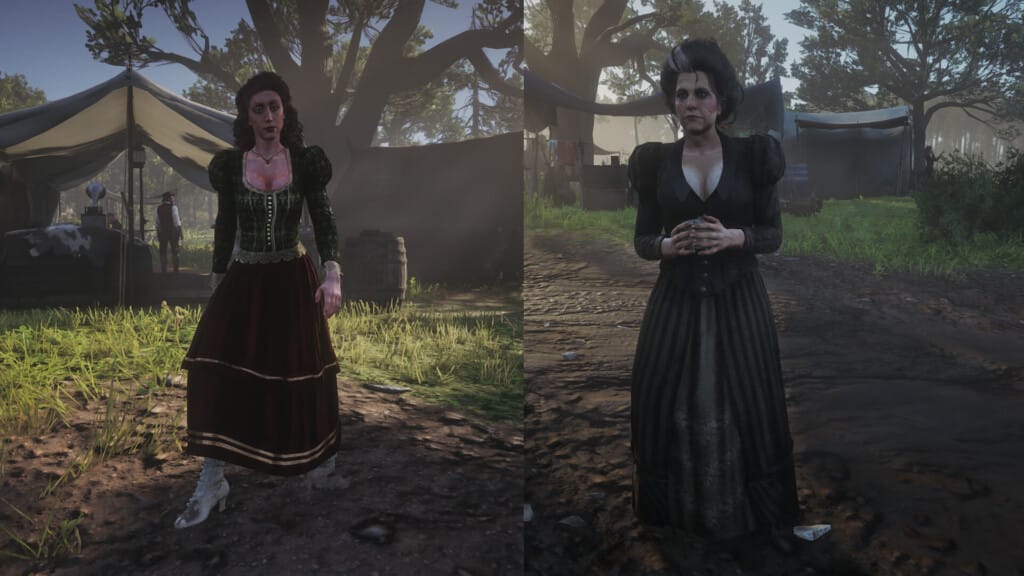
Most poignantly, not long after Susan murders Molly, she is herself murdered. Despite the fact that the angle is impossible — the blood spatter shows the bullet enters at roughly a 90-degree angle from where Micah is shooting — she’s shot in exactly the same part of the body she shot Molly — below the left breast — feet from where Molly died.
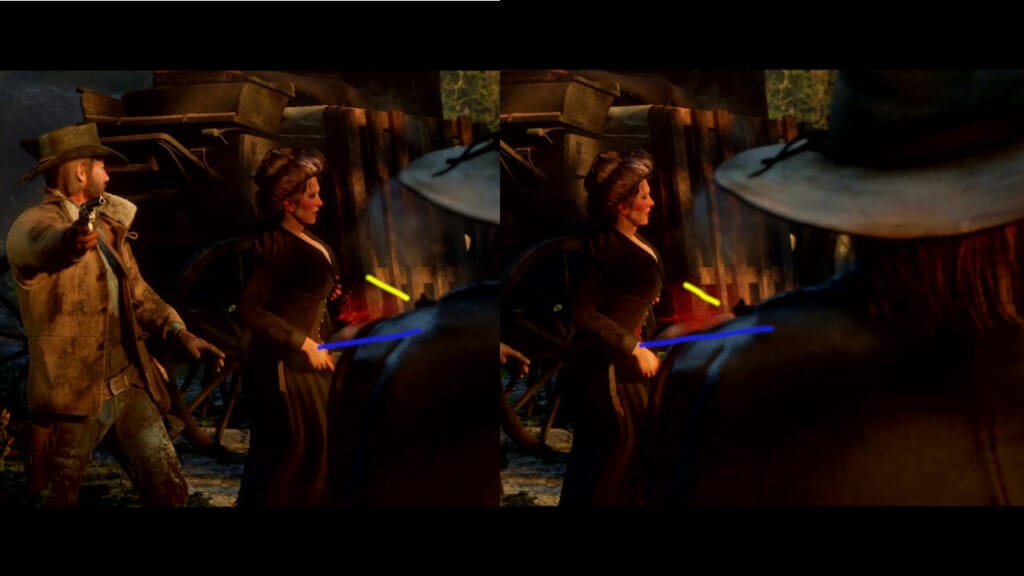
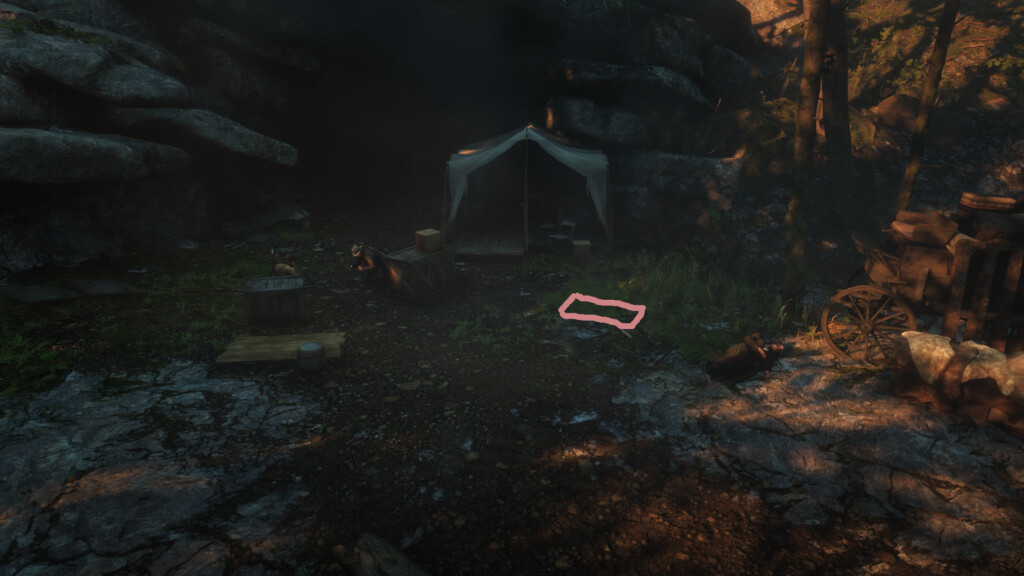
Logically speaking, Susan’s body should have burned (as she ordered Molly’s to be). The Pinkertons set the camp on fire, and Charles buried Susan, so the Pinktertons didn’t take her body. However, if the player returns to camp, there’s a void in the fire where her body fell, and the body itself is missing. Perhaps Rockstar decided that even for them, the image of a partially-burned corpse of a character we probably like at least a little is a bit much. Perhaps they realized (and on balance this seems less likely) that if they burned three loud-mouthed women5, we might start to notice what was going on.
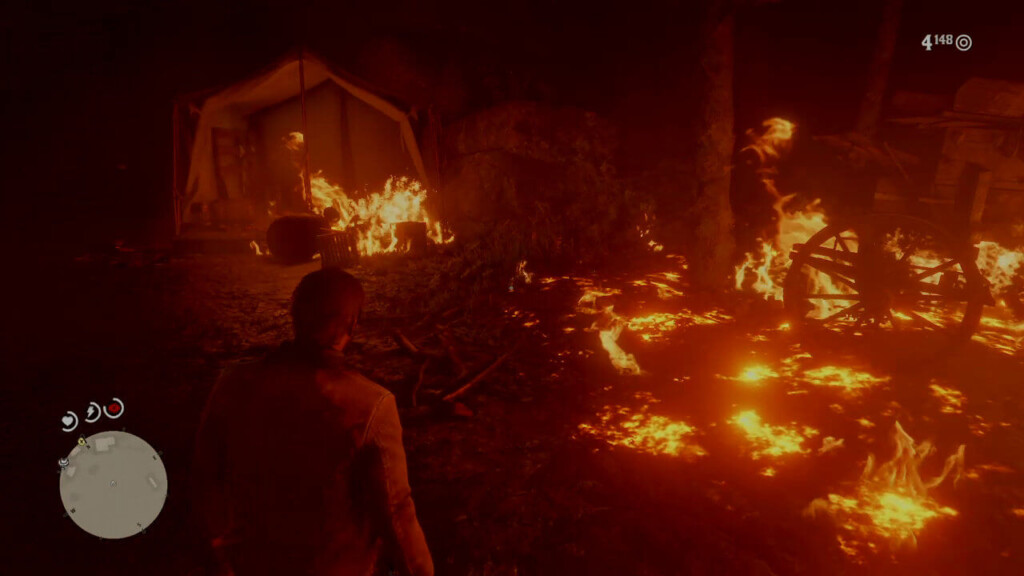
It seems likely that Susan’s last name comes from the Victorian painter Atkinson Grimshaw, who painted the Lady of Shalott and Elaine of Astolat several times. The priest at the church in Rhodes also has the last name Grimshaw; in RDR2, repeated names are usually allusions (as with Annabelle and Isaac). Grimshaw, like some of the writers whose works inspired RDR2, died of tuberculosis. Whether he’s alluded to for this reason or that’s simply a reflection of how prevalent and deadly tuberculosis was is unclear.
Molly O’Shea & Queen Guinevere. Molly also has some similarities to Queen Guinevere. Dutch is a King Arthur figure, and she’s romantically involved with him. Guinevere is prone to jealousy, as is Molly (although Molly has reason, and Guinevere’s jealousy is unfounded). Guinevere is supposed to be burned to death in legend, and Susan orders Molly’s body burned.
Susan Grimshaw and Sir Kay. Although, as Molly’s double, Susan is loosely associated with the Lady of Shalott, Susan’s primary similarity to a character in another work is to Sir Kay of Arthurian legend. Sir Kay is King Arthur’s steward, responsible for keeping his court running smoothly and looking after domestic matters. Susan fulfills the same function for Dutch. Their similarities extend beyond the superficial: Kay is notoriously ill-mannered, but he’s still brave, just as Susan shows she is in “No, No, and Thrice No.” In Chrétien de Troyes’ “The Story of the Grail,” Kay strikes a young woman so hard that he “knocked her to the ground” (394). Susan does the same thing to Karen in a camp interaction (Clemens Point).
Bill Williamson and Sir Kay. Bill also has similarities to Sir Kay. He, too, is rude and unkind, but decent in a fight. (See also: “Kieran Duffy, Branwen, and Sir Gareth,” below.)
Javier Escuella and Sir Gawain. In the legends, Gawain develops a bitter and vengeful fury towards Lancelot after Lancelot unintentionally kills Gawain’s brother, Gareth. Gawain’s anger and sense of betrayal likely inform the way that Javier begins treating Arthur, John, and Charles around camp. Unfortunately, in the absence of an event parallel to Gareth’s death in RDR2, his actions lack sufficient foregrounding in what we’ve seen of his character up to that point to be believable — that is to say, it’s bad writing. Javier siding with Dutch is basically understandable; Javier stalking around spitting vitriol at everyone who isn’t on his side is not.
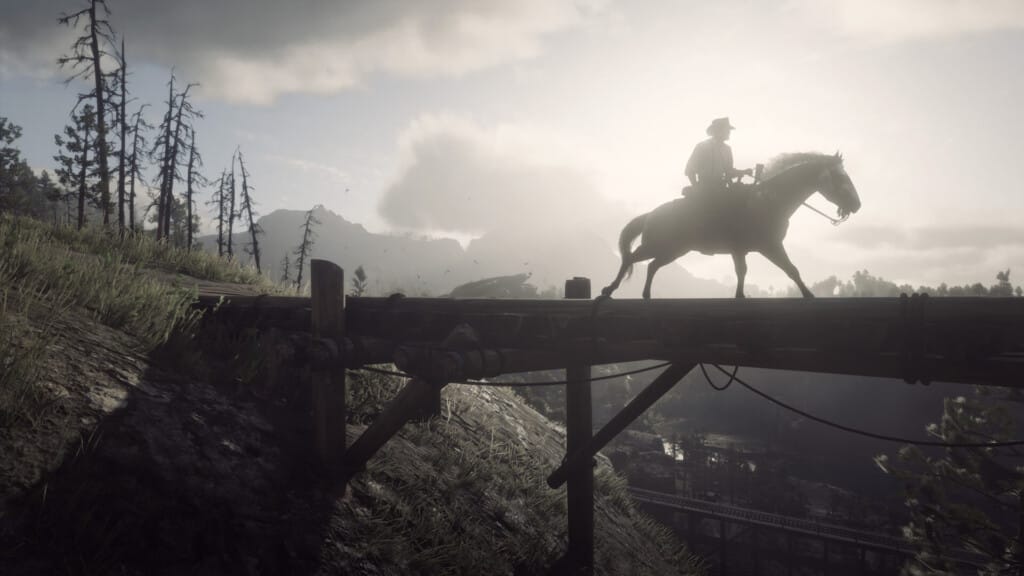
Kieran Duffy, Branwen, and Sir Gareth. The Mabinogion is a modern-day label for a diverse collection of stories (The Mabinogion x), one of which was a particular influence on Kieran’s character. In the Second Branch of The Mabinogion, the king of Ireland (Matholwch) marries Branwen, sister of the king of England (Bendigeidfran, or Bran the Blessed). Their brother, Efnysien, feels insulted that he wasn’t consulted prior to her marriage and mutilates Matholwch’s horses. Although Bendigeidfran gives Matholwch compensation, including a magical cauldron that will bring a dead man back to life if he’s placed inside, eventually the people of Ireland convince Matholwch that the insult was too great to be borne.
In revenge, Branwen is sent to work in the kitchens, where she’s abused. She befriends a bird, which she teaches to carry a letter to Bendigeidfran. He takes an army to rescue and avenge her. Eventually, Bendigeidfran is mortally injured. He orders his head to be cut off, after which it continues to speak. Branwen dies of grief over the wars.
Several elements of this story are present in Kieran’s: the prominence of horses, a character being abused as a lackey by a group of Irish people, that character’s affinity with animals, and a beheading (more on that in the “Motifs and Symbols” section of next week’s post). During the wars, Branwen’s son is murdered by being thrown into a fireplace. She tries to jump in after him to save him. When Jack is missing, Kieran tells Abigail, “I would gladly give my life for his.” His horse is named Branwen to highlight his similarities with that character.
Branwen’s story is also similar to “The Tale of Sir Gareth of Orkney” in Le Morte Darthur. Gareth is a noble young man who goes to King Arthur’s court in disguise. Sir Kay “scorned him and mocked him” (121) and put him to work in the kitchens. Sir Kay’s bullying of Gareth has a parallel in Bill’s treatment of Kieran.
Josiah Trelawny & Gwydion. Josiah Trelawny’s horse is named Gwydion, for the Welsh trickster of folktale. Arthurian legend originated in Wales. Trelawny is himself a trickster figure, a “kind devil,”6 as Mary-Beth Gaskill puts it. Like Branwen, Gwydion appears in The Mabinogion. His story there makes one question why, exactly, the writers thought it an appropriate allusion: the plot of the tale is Gwydion going to great lengths to help his brother to rape a woman. While there is no suggestion that Trelawny would do such a thing, other parallels are apparent: both men are magicians (although Gwydion is a real practitioner of magic, not sleight of hand) and conjure black and white animals — Gwydion conjures up horses and hounds that are black with white breasts (The Mabinogion 49), and in camp, Trelawny produces a crow and a dove7.
Hosea Matthews and Merlin. Hosea’s character is informed in part by Merlin, the magician and adviser to King Arthur. Merlin is King Arthur’s first supporter, just as Hosea is Dutch’s. Although Dutch frequently dismisses him, Hosea is one of the only people who attempts to offer him guidance. King Arthur similarly ignores Merlin’s most important advice: that if he married Guinevere, it will lead to the destruction of his court. (Hosea is named for the Biblical prophet, which we’ll get to in due time.)
Eventually, Merlin is imprisoned in a rock or tree. He tells Arthur that this is going to happen beforehand. When Arthur asks why he doesn’t use his magic to avoid this fate, he simply says “it will not be” (Malory 58). One of the puzzling plot points in RDR2’s story is that Hosea wants to rob Lemoyne National Bank immediately after Dutch kills Angelo Bronte — a move which Hosea has already warned Dutch and Arthur “will damn us all” (“Country Pursuits”). Perhaps this makes more sense in light of Merlin’s decision not to attempt to avoid his own fate (such attempts, mythology says, always go wrong). Then again, given that Hosea has continuously tried to help the gang and its members survive8, perhaps not.
- Molly’s Companion Request, Clemens Point. The mirror she asks for (“Molly’s mirror”) can be found at Martha’s Swain — where another woman has died for love. ↩︎
- For instance, an interaction with Karen Jones at Shady Belle, one with Abigail Roberts at Clemens Point, and Arthur Morgan, if the player chooses to interact. ↩︎
- Some of Arthur’s dialog when Antagonizing Susan makes this clear: “I remember when you were Dutch’s number one, Miss Grimshaw. Now, you’re a number I can’t even count up to.” ↩︎
- All of these interactions are specific to Clemens Point. ↩︎
- Camp dialog, observed Clemens Point and Shady Belle. ↩︎
- Separate incidents, one with Karen and Susan, and one with Mary-Beth and Karen. Observable at Clemens Point and Shady Belle. ↩︎
- See, for instance, “Who the Hell is Leviticus Cornwall?,” “A Strange Kindness,” “Country Pursuits,” camp interactions with Lenny Summers, Abigail Roberts, and John Marston. ↩︎
New here? Visit the Table of Contents to read the essays in order, or the Index & TL;DR to explore the site by topic. New essays are published Wednesdays at 1 p.m. E.T./10 a.m. P.T. Sharing the site is always appreciated!
Bibliography
Expand to view sources.
- Anonymous. The Death of King Arthur. Translated by James Cable. Penguin Books, 1971.
- Anonymous. The Mabinogion. Translated by Sioned Davies. Oxford University Press, 2007.
- Chrétien de Troyes. Arthurian Romances. Translated by William W. Kibler. Penguin Books, 1991.
- Houser, Dan, et al. “Red Dead Redemption II.” Rockstar Games, 2018.
- “John Atkinson Grimshaw.” Wikipedia, Wikimedia Foundation. 20 July 2024. https://en.wikipedia.org/wiki/John_Atkinson_Grimshaw.
- Lupack, Alan. Oxford Guide to Arthurian Literature and Legend. Oxford University Press, 2005.
- Malory, Sir Thomas. Le Morte Darthur. Edited by Helen Cooper. Oxford University Press, 1998.
- Tennyson, Alfred. “The Lady of Shalott (1842).” Poetry Foundation. https://www.poetryfoundation.org/poems/45360/the-lady-of-shalott-1842.
- “Uaibhreach.” Wiktionary, Wikimedia Foundation. 2 Mar. 2024. https://en.wiktionary.org/wiki/uaibhreach.
